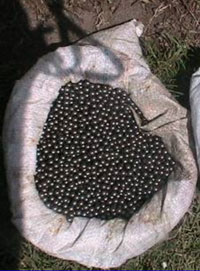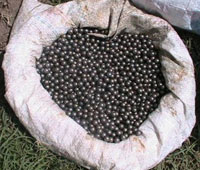
Eelam war IV erupts in the Wanni
Reports of a group of Tiger guerrillas, said to be around 50, hovering in an area south of the Madhu Church and just ahead of their defended localities astride Mannar caused serious concerns for the security establishment. Were they on a mission to attack troop positions? Air raids on the group set a poser. There were civilian settlements in the area where the group was moving around. On Friday, the Army's newly established 57 Division decided to take on the group in what they believed was a pre-emptive strike. During such a move, they also planned to neutralize guerrilla artillery and mortar positions. The latter task was also being undertaken simultaneouly by small groups operating ahead of the defence lines. Troops broke out of their defence lines to advance towards the guerrilla positions. They had penetrated some four kilometers when bitter gun battles erupted with the Tiger guerrillas in the general area east of the Giant's Tank. By Friday night, nine soldiers were killed. Six others were described as P1 or in a serious condition. A further four were described as P 2. That would leave them out of battle for sometime. Yet another five officers and 48 soldiers were classed as P3 or walking wounded. Eight of the dead were from the 8th battalion of the Sri Lanka Light Infantry (SLLI) whilst one was from the 6th battalion of the Vijayaba Infantry Regiment (VIR), both now components of the new 57 Division. The injured were moved to the Anuradhapura base hospital in batches on Friday night. The Liberation Tigers of Tamil Eelam (LTTE) had a different story to tell about the incident. Their Peace Secretariat web site accused the Army of launching heavy artillery and Multi Barrel Rocket Launcher attacks on Periya Pandivirichchan located two kilometers east of Madhu Church. It said heavy artillery and MBRL rocket fire was stepped up on civilian settlements. It charged that that the firing came from the Army camp in Piramanalankulam Junction on the Mannar-Vavuniya Road and the one at Madhu Road junction on Mannar - Medawachchiya Road.
The LTTE quoted NGO officials as claiming that 2000 families were displaced from villages east of Madhu towards Iluippaikkaikadavai, Vellankulam, Jeyanthinagar and Kilinochchi. State intelligence agencies have alerted security authorities to take steps to prevent an exodus of refugees to South India. They have warned that the LTTE may encourage the move in a strong bid to win sympathy in Tamil Nadu. Notwithstanding each other's accusations or suspicions, it is clear both the Security Forces and Tiger guerrillas have been prepared. As expected, Friday's confrontation marks the return and escalation of the undeclared Eelam War IV in the Wanni. This is in the backdrop of reports in the past weeks of military preparations for which the two sides have been publicly accusing each other. Friday night's fighting prompted the troops to make a tactical withdrawal to their original positions. Offensive action was temporarily halted. This was after battles had raged for over 12 hours. Some 51 Sinhala civilians who were forced to flee the fighting have ended up in the Vavuniya town. In a move that made clear the LTTE is poised to step up attacks, the Entry-Exit point at Omanthai, now the lifeline for civilians in the Wanni, also came under attack. It prompted the Army to promptly shut down the facility. It was re-opened yesterday. On the same day, in the Government-controlled Jaffna peninsula the Army seized a variety of items from a lorry parked near a house. They included a large haul of explosives, claymore charges, remote-controlled devices and satellite phones. Yesterday, a guerrilla suicide bomber exploded himself outside an Army position in the Jaffna town killing one soldier and wounding three others. The intensified action by the LTTE in the Wanni and the Jaffna peninsula is in addition to its efforts to step up attacks in the East. Last Wednesday, in a bid to demonstrate that they have not altogether given up the Batticaloa district, Tiger guerrillas planned an attack on the Army detachment in Sittandy just past 2 am. However, it failed. Two heavily-explosive-laden trucks had exploded prematurely at Red Bridge near the detachment. Four soldiers and two civilians employed by the Army were killed and 17 others were wounded. Also killed was a civilian passerby. Thirty two other civilians were injured. The Army said they found the bodies of eight guerrillas and added that according to radio intercepts 18 guerrillas had been killed. Independent verification of these figures is not possible. In other confrontations in the Batticaloa district for the period February 24 to March 7, Army sources say, nine soldiers were killed, three missing and 55 wounded. They say 67 guerrillas were killed and 83 wounded. Among the items recovered by the Army from the scene of the incident were six T-56 assault rifles, a Light Machine Gun, a Rocket Propelled Grenade and 2,000 rounds of (T-56) ammunition. This week both the Army and the Police Special Task Force (STF) continued their joint operations in the Batticaloa district. President Mahinda Rajapaksa was briefed last Wednesday on these joint operations. This was both by the Commander of the Army Lt. Gen. Sarath Fonseka and the Commandant of the STF, Nimal Lewke DIG. The two were to commend each other's role in their new tasks. He also heard details about the Navy's reported destroying of two LTTE weapons ships in the deeper seas off the eastern coastal town of Arugam Bay. However, powerful sections in the security establishment held a different but well recorded version of how the incident occurred. But this was not detailed out. Quite apart from this, from January 2006 to February 2007, the Navy has either rounded up or destroyed LTTE cargo vessels or trawlers in 13 separate incidents. Ten of these incidents took place last year whilst the rest in February this year. On both February 16 and 22, they made two important finds. The first was an LTTE boat carrying more than a million steel balls of varying sizes used for the manufacture of claymore mines and suicide jackets. The other was when they apprehended a Sea Tiger boat mounted with a 14.5 mm gun. Both discoveries were made in Kalpitiya, an official at Navy Headquarters said yesterday. Intensified anti-guerrilla operations in the Batticaloa district came as intelligence agencies reported that the LTTE had moved two 152 mm artillery guns into the general area of Toppigala or Baron's Cap. Whilst small groups were engaging guerrilla targets there, intelligence sources reiterated yesterday that large groups of guerrillas were shifting from the east to the northern theatre. This was whilst retaining a limited presence in the east to engage the Security Forces and thus drive home the point that they have not ceded the entire east. A hitherto lesser known feature of the ongoing undeclared Eelam War IV is the great sacrifice being made by personel of the Army, Navy, Air Force, Police and Home Guards. Since, December 2005 January 1, 2007, according to the Media Centre for National Security (MCNS), a total of 945 were killed. Here is a break down: Army (599), Navy (226), Air Force (7), Police (72) and Home Guards (41). There were hardly any incidents in November 2005 when Presidential Elections were held. Hence, the casualty figures are for the period that began after the Presidential polls. These figures include some of the major incidents since the outbreak of hostilities after the LTTE blockaded the Mavil Aru anicut. The move deprived water to over 25,000 acres of paddy land in the Batticaloa district and prompted a military offensive that began on July 28 last year. On August 8 of the same year, the sluice gates were re-opened. Two officers and 15 soldiers were killed in the fighting. A further eight officers and 113 soldiers were wounded. Army officials say 35 guerrillas were killed and 75 cadres were wounded. When Security Forces attacks got under way in Mavil Aru, Tiger guerrillas mounted an offensive in Mutur and villages south of it. The three-day offensive began on August 3 and led to the deaths of 12 soldiers. Seven officers and 94 soldiers were wounded. Army officials say 99 guerrillas were killed and 124 wounded. On August 11, last year, in a bid to place a siege on the Jaffna peninsula, Tiger guerrillas carried out attacks on several Security Forces positions in the Jaffna peninsula. This included attacks on the Entry-Exit point at Muhamalai (now closed), an attack on the Naval Sub Unit and the seizure of Kayts island, a fact hitherto unknown. The Army deployed a team of commandos to recapture Kayts island after it was in guerrilla hands for two days. Later, during a two day offensive, troops hit back at LTTE positions and returned to the original positions at Muhamalai. According to sources at the Security Forces Headquarters Jaffna (SFHQ-J), 17 officers and 180 soldiers died in the fighting. A further 47 officers and 778 soldiers were wounded. These sources said over 350 guerrills were killed and more than 400 wounded. Later on August 27 the Army launched a week-long operation to recapture Sampur. This was the location from which the guerrillas directed artillery fire at the Dockyard, home for the Navy's Eastern Naval Area Headquarters and the Sri Lanka Air Force base in China Bay. In fact, the recapture of this strategic location, as revealed in The Sunday Times, was recommended by a team from the United States Army's Pacific Command. In this encounter, Army officials say, 20 soldiers were killed. Eleven officers and 156 soldiers were wounded. They said nearly 200 guerrillas were killed and over 60 wounded. On September 5 last year, the Army launched an offensive to capture the LTTE's frontlines facing the Muhamalai Entry-Exit point. This forced the LTTE to fall back to their next line. The near three day offensive led to two officers and 36 soldiers being killed. A further ten officers and 201 soldiers were wounded. Army officials said more than 225 guerrillas were killed and over 250 wounded. This was followed by the infamous debacle at Muhamalai on October 11 after an Army advance was foiled. According to figures revealed by sources at SFHQ Jaffna 12 officers and 124 soldiers were killed during this day long encounter. A further 24 officers and 490 soldiers were wounded whilst three soldiers were declared missing in action. They said 175 guerrillas were killed and more than 220 wounded. With the guerrillas now poised for attacks both in the Northern and Eastern theatre, fears of the current fighting reaching a new high are gaining momentum. It comes at a time when the Government is busying itself to expedite the formulation of political proposals to end the ethnic conflict. Quite clearly, a heightened war seems closer than a hopeful peace as another national New Year closes in. |
|| Front
Page | News | Editorial | Columns | Sports | Plus | Financial
Times | International | Mirror | TV
Times | Funday
Times || |
| |
Copyright
2007 Wijeya
Newspapers Ltd.Colombo. Sri Lanka. |


